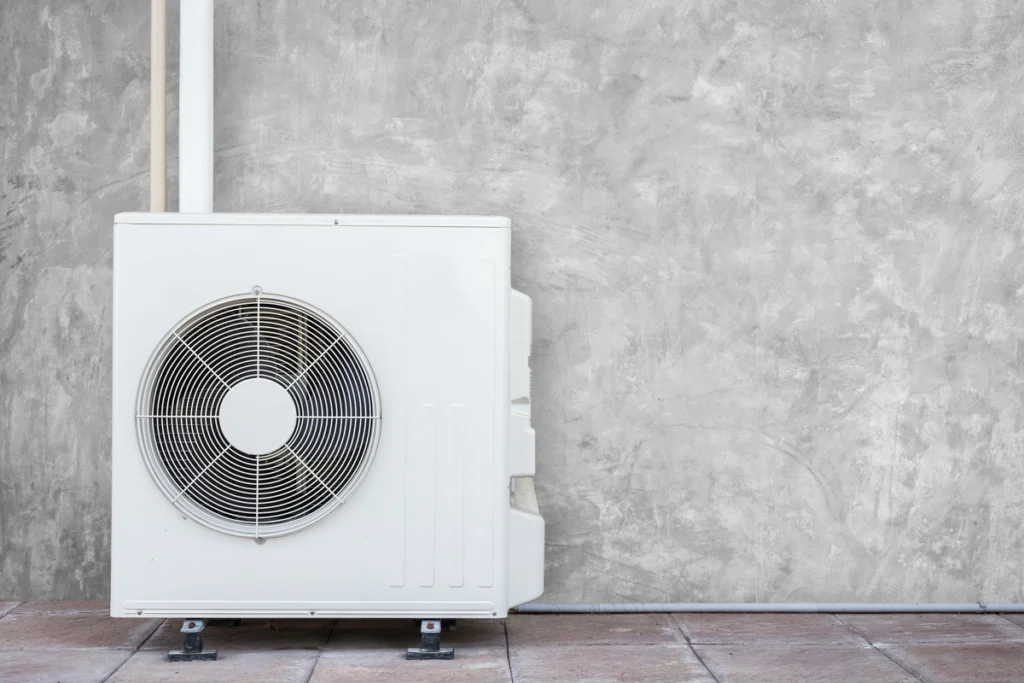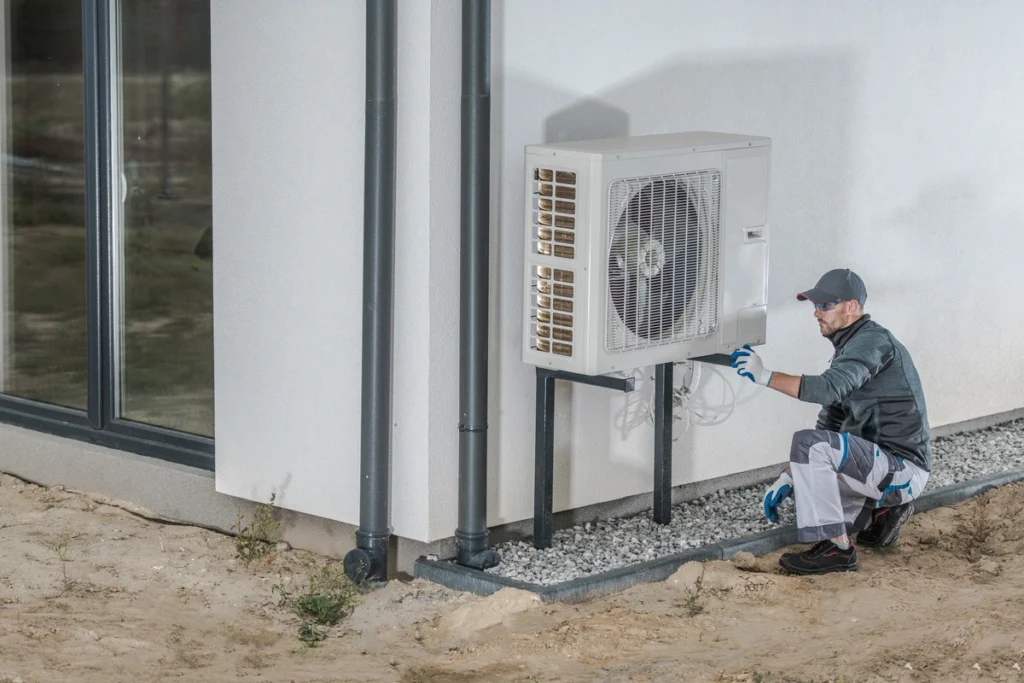In the realm of HVAC (Heating, Ventilation, and Air Conditioning) systems, heat pumps are often heralded as versatile and efficient solutions for both heating and cooling needs. But what does a heat pump look like?
In this expert blog post, we’ll delve into:
- What heat pumps look like
- What they do
- How to take care of them
- When to replace a heat pump
What is a Heat Pump?

Before diving into its appearance, let’s understand what a heat pump actually is. A heat pump is a device that transfers heat from one location to another, typically from a lower temperature to a higher temperature, using mechanical work. Essentially, it moves heat rather than generating it, making it an energy-efficient option for both heating and cooling.
Heat pumps operate on the principle of refrigeration cycle, similar to that of a refrigerator or air conditioner, but with the ability to reverse the flow of refrigerant. During the winter months, the heat pump extracts heat from the outside air (even in cold temperatures) and transfers it indoors to warm your home. Conversely, in the summer, it removes heat from your indoor space and releases it outside to cool your home.
What Does a Heat Pump Look Like?
Now, let’s get to the visual aspect. A heat pump typically consists of two main components:
Outdoor Unit:
This is the part of the heat pump system that sits outside your home. It usually resembles a large metal box or cabinet and contains the compressor, condenser coil, and a fan. The compressor is responsible for compressing the refrigerant, while the condenser coil facilitates the transfer of heat.
Indoor Unit:
Unlike traditional furnaces, heat pumps don’t require a separate indoor unit for heating. Instead, they utilize the existing ductwork in your home for air distribution. Therefore, the indoor unit of a heat pump may not be as conspicuous. It could be integrated with your existing HVAC system, typically comprising an air handler or a fan coil, depending on the setup.
The outdoor unit is often larger and more noticeable compared to the indoor unit. Its size can vary depending on the capacity of the heat pump and the manufacturer’s design.
How to Locate Your Heat Pump
Locating your heat pump is crucial for maintenance, troubleshooting, and ensuring proper airflow. Here are some common places to find your heat pump:
- Backyard or Side Yard: Most residential heat pumps are installed outdoors due to space considerations and noise reduction. They are often placed in the backyard or on the side of the house, away from windows and living areas.
- Roof: In some cases, especially in urban areas or where space is limited, heat pumps might be installed on the roof of the building. This placement requires proper support and access for maintenance.
- Garage or Basement: In rare instances, particularly in colder climates, you may find heat pumps installed indoors, such as in a garage or basement. This setup protects the unit from extreme weather conditions and may be preferred in regions with heavy snowfall.
Locating your heat pump ensures easy access for routine maintenance tasks and allows for timely repairs if issues arise.
6 Signs You Need to Replace Your Heat Pump
While heat pumps are known for their durability and longevity, there comes a time when replacement becomes necessary. Here are some signs that indicate it might be time to replace your heat pump:
1) Age:
Like any mechanical system, heat pumps have a finite lifespan. If your heat pump is over 10-15 years old and experiencing frequent issues, it might be more cost-effective to replace it with a newer, more efficient model.
2) Decreased Efficiency:
If your energy bills are steadily increasing despite regular maintenance, it could indicate that your heat pump is losing efficiency. Newer models are often more energy-efficient and can help you save on heating and cooling costs.
3) Frequent Repairs:
Constant breakdowns and repairs can be a drain on your finances and indicate underlying issues with your heat pump. If you find yourself calling for repairs more often, it might be time to consider a replacement.
4) Strange Noises:
Unusual sounds such as grinding, squealing, or banging coming from your heat pump could signal mechanical problems that warrant replacement.
5) Uneven Heating or Cooling:
If certain areas of your home are consistently colder or warmer than others, it could indicate that your heat pump is struggling to maintain consistent temperatures, which may necessitate replacement.
6) Refrigerant Leaks:
Refrigerant leaks not only affect the performance of your heat pump but can also pose health and environmental risks. If you notice refrigerant leaks, it’s important to address them promptly and consider replacing your heat pump if the leaks are extensive.
Why You Should Always Work With a Professional

When it comes to installing, repairing, or replacing a heat pump, it’s essential to enlist the help of a qualified HVAC professional. Here’s why:
- Expertise: HVAC technicians have the knowledge, training, and experience to properly assess your heating and cooling needs, recommend the right size and type of heat pump, and ensure correct installation.
- Safety: Working with HVAC systems involves handling electrical components, refrigerants, and complex machinery. Professionals are equipped with the necessary safety gear and follow industry regulations to ensure the safety of your home and family.
- Warranty Coverage: Many manufacturers require professional installation to validate warranty coverage. Attempting DIY installation or repairs could void your warranty and leave you responsible for costly repairs or replacements.
- Code Compliance: HVAC professionals are familiar with local building codes and regulations governing the installation and operation of heat pump systems. They ensure that your system meets all legal requirements and passes necessary inspections.
- Long-Term Savings: While hiring a professional may seem like an added expense upfront, it can save you money in the long run by preventing costly mistakes, maximizing energy efficiency, and prolonging the lifespan of your heat pump.
How to Maintain Your Heat Pump
Proper maintenance is key to keeping your heat pump running smoothly and efficiently. Here are some essential maintenance tasks:
- Regular Filter Replacement: Clean or replace air filters every 1-3 months to ensure proper airflow and indoor air quality.
- Clean Outdoor Unit: Keep the outdoor unit free of debris, such as leaves, dirt, and grass clippings, to maintain optimal airflow and prevent overheating.
- Check Thermostat Settings: Verify that your thermostat settings are correct for the season and adjust as needed for comfort and energy savings.
- Inspect Ductwork: Periodically check for leaks, gaps, or damage in your ductwork and seal or repair as necessary to prevent energy loss.
- Schedule Professional Maintenance: Consider scheduling annual maintenance visits with a qualified HVAC technician to inspect, clean, and tune up your heat pump for peak performance.
- Monitor Performance: Pay attention to any changes in your heat pump’s performance, such as unusual noises, reduced airflow, or increased energy consumption, and address them promptly to prevent further issues.
Professionals That You Can Trust
A heat pump is a versatile HVAC system that provides both heating and cooling by transferring heat between indoor and outdoor environments. It typically consists of an outdoor unit containing the compressor and condenser coil, as well as an indoor unit for air distribution. Locating your heat pump, recognizing signs of wear and tear, working with a professional for installation and repairs, and maintaining your system are essential for maximizing efficiency, comfort, and longevity.
Get help handling your heat pump when you contact Palmetto Heating & Air.
